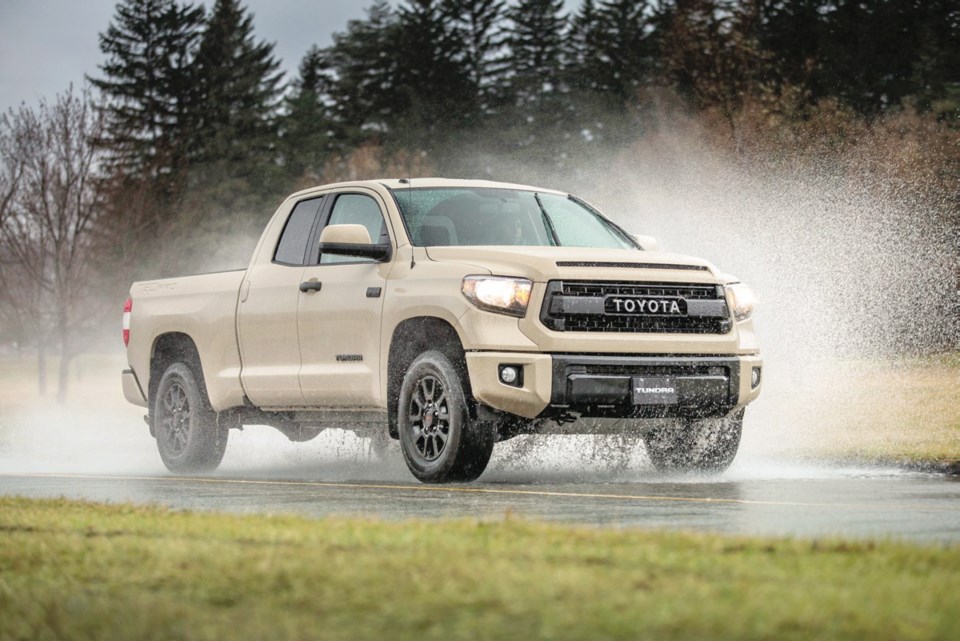Urban cowboys or people who like playing in the mud will find lots to like in the 2017 Toyota Tundra.
The Tundra is ToyotaŌĆÖs entry in the full-size truck segment, a market dominated by the Big Three ŌĆö Ford, General Motors and Ram.
What Toyota has done is leveraged its know-how building reliability into small passenger cars into an offering on the other end of the spectrum.
Early on, Toyota realized that if you want to beat the competition at their own game, you have to join them.
To that end, Toyota builds all of its full-size trucks out of an assembly plant in San Antonio, Texas ŌĆö literally in the heart of truck country, U.S.A.
Trucks are unlike cars in that the shape doesnŌĆÖt change much, year-in and year-out. The majority of annual changes can be found on the vehicleŌĆÖs grille and front end, as the back end is just an empty box.
This is only the second generation of the Tundra, which was first introduced in 1999. (There was also one other full-size truck, the Toyota T100, which was sold in North America between 1992 and 1998).
Size-wise, it is within millimetres of the GM, Ram and the Nissan Titan (the only other Asian manufacturer that offers a full-sized truck). The one standout is its standard 144-litre fuel tank, the largest of the group.
The Tundra can be ordered in either two- or four-wheel drive. One can order between a regular cab and long box, a double cab or four-door (which Toyota calls the Crewmax). In the 4x4 line, one can choose between a 4.6-litre V-6 or 5.7-litre V-8.
I drove a 4x4 double-cab SR model with the V-8 and an optional TRD (Toyota Racing Development) Pro package.
The heart of the truck is a naturally aspirated 32-valve, aluminum V-8 producing 381 horsepower and 401 foot-pounds of torque. It produces more horsepower compared with the Ford F-150, the best-selling truck in Canada. On the other hand, the F-150, which is equipped with a turbocharged 3.5-litre V-6, produces almost 70 ft.-lb. more torque. Keep in mind that although the Ford can operate on┬Āregular fuel, to get peak performance, owners need to upgrade to a┬Ādiet of premium-grade fuel. The Tundra can develop its peak power just on good olŌĆÖ regular fuel.
A strong push on the accelerator can hustle the Tundra along briskly, with the zero-to-100┬Ākm/h dash in just over seven seconds.
Perhaps more importantly, it can tow up to 4,490 kilograms (9,899 lbs.), thanks to a tow package that is part of the TRD Pro package. A trailer brake controller and sway control is also part of that same suite.
The 6.5-foot cargo bed comes with bed rails and adjustable tie-down cleats. The back window (to the truck bed) also can be opened, to allow super-long items to pass through or to access the bed from inside the truck.
I was impressed with the TundraŌĆÖs six-speed automatic. On paper, it looks dated, as competitors have moved to install seven, eight and even 10-speed transmissions.
But the truth of the matter was that the six-speed performed flawlessly. On occasion, vehicles with more speeds donŌĆÖt necessarily derive any great gains in driveability owing to the transmission constantly shifting in an effort to find the perfect ratio. The TundraŌĆÖs transmission upshifted seamlessly and was quick to downshift when called upon.
The TRD Pro package is a boon to people who like to off-road, with Bilstein shock absorbers, all-terrain tires and under-vehicle protection for the engine, transfer case and fuel tank.
In a market almost tripping over itself in offering more and more luxury features, the Tundra feels rather utilitarian. It has a more subdued interior design, devoid of plastic wood and chrome. In a way, it is refreshing.
The centre of the dash is dominated by an infotainment system that boasts a 7-inch touchscreen with navigation, satellite radio, Bluetooth and a back-up camera.
There is also a blind-spot monitor system and clearance and back-up sensors to aid in parking.
Even tall or large adults wonŌĆÖt complain about the generous rear bench seats, which boasts under-seat storage.
To succeed in the full-size truck segment, one must constantly build a better mousetrap. The Toyota Tundra has all the right ingredients to succeed, with its vaunted reliability as the trump card.
the spec sheet
Type: Full-size extended-cab pick-up truck, front engine, 4x4
Engine: 5.7-litre V-8, 381 hp at 5,600 r.p.m., 401 lb.-ft. of torque at 3,600 r.p.m.
Transmission: Six-speed automatic
Dimensions (mm): Length, 5,815; width, 2,030; height, 1,940; wheelbase, 3,700
Curb weight (kg): 2,480
Price (base/as tested): $44,740/ $59,380 (includes $1,760 freight and PDI and $100 AC tax)
Options: TRD Pro package $12,780
Tires: 275/65 R18 on alloy wheels
Fuel type: Regular
Fuel economy (L/100km):
Warranty: Three years/60,000 km new car, five years/100,000 km powertrain



